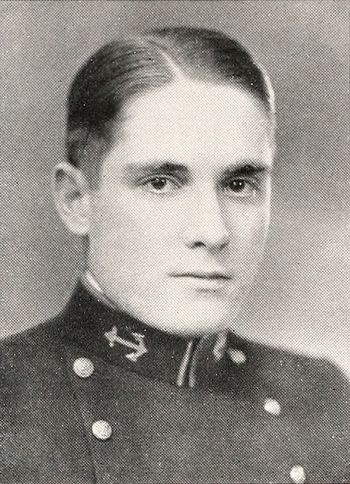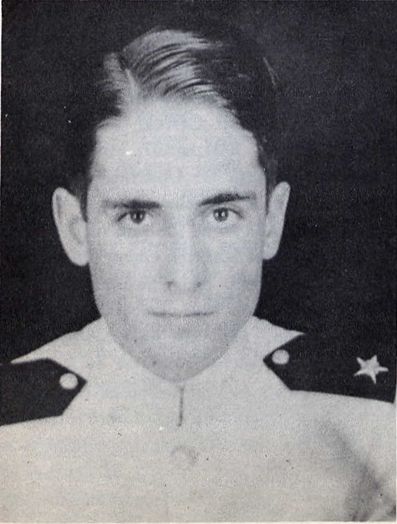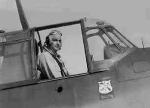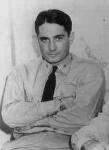ROBERT H. ISELY, CDR, USN
Robert Isely '33
Lucky Bag
From the 1933 Lucky Bag:
ROBERT HENRY ISELY
Dodge City, Kansas
"Bob"
Dodge City is justly proud of her son Bob, who fared forth to see the world and, incidentally, to absorb some knowledge via the Naval Academy. Not only has he carried out his first intentions but also he has become a fancier of bright lights of white ways, spending his leaves making life dangerous for the girls of the "Vanities." At present the focus of his attentions moves southward, having gotten as far as New Jersey where it seems it will remain a while.
In between conquests Bob spent his time at the Academy carrying away honors in the orchestra, glee club, and musical shows. He was elected leader of the orchestra, thus realizing a life-long ambition. When not rehearsing Bob was a competent soccer player. Everything else do I understand, but how can a man arise before reveille every morning and run two miles? What a man!
Orchestra 4, 3, 2, 1; Lucky Bag Staff; Reef Points Staff 4, 3; Glee Club 4, 3, 2; Soccer 4; Choir 3, 2, 1; Reception Committee 3; 2 P. O.
Bob was a member of the Choir and Orchestra. He was also Photographic Business Manager of the Lucky Bag.

ROBERT HENRY ISELY
Dodge City, Kansas
"Bob"
Dodge City is justly proud of her son Bob, who fared forth to see the world and, incidentally, to absorb some knowledge via the Naval Academy. Not only has he carried out his first intentions but also he has become a fancier of bright lights of white ways, spending his leaves making life dangerous for the girls of the "Vanities." At present the focus of his attentions moves southward, having gotten as far as New Jersey where it seems it will remain a while.
In between conquests Bob spent his time at the Academy carrying away honors in the orchestra, glee club, and musical shows. He was elected leader of the orchestra, thus realizing a life-long ambition. When not rehearsing Bob was a competent soccer player. Everything else do I understand, but how can a man arise before reveille every morning and run two miles? What a man!
Orchestra 4, 3, 2, 1; Lucky Bag Staff; Reef Points Staff 4, 3; Glee Club 4, 3, 2; Soccer 4; Choir 3, 2, 1; Reception Committee 3; 2 P. O.
Bob was a member of the Choir and Orchestra. He was also Photographic Business Manager of the Lucky Bag.
Loss
Robert was killed in action on June 13, 1944 when his aircraft was shot down while leading a bombing attack over Saipan. He was commanding officer of Torpedo Squadron (VT) 16, flying from USS Lexington (CV 16).
Other Information
From the 1953 edition of the book "Double Three Roundup," published by the class of 1933:
Upon graduation, Bob took a position with R. H. Macy in New York, which he held until recalled to active duty the next year. From June 1934 to January 1937 he served in the CHESTER where life was made interesting by a cruise to the Philippines, Japan and China with Secretary of War Dern, and by another to South America with President Roosevelt.
In January 1937 he reported to Pensacola for aviation instruction. He received his wings in December, and his first aviation assignment was in connection with fitting out the aviation unit of the BOISE at NOB, Norfolk. In June 1940 he went to Torpedo Squadron TWO in the LEXINGTON. With the step up in Naval Air Flight Training, he was ordered to Pensacola as an instructor eight months later. During his tour Bob's musical talents were much in evidence. He was officer representative of the cadet Glee Club for which he arranged music and wrote songs. His "Notice to Airmen" — an advisory poem to newly graduated aviators became a standard adjunct to each set of wings awarded. During this time at Pensacola, Bob also wrote the following songs: "Here Comes Your Uncle Sam", "Out There Somewhere", and "Wings Over the Navy". The latter was used as the theme song in a Warner Bros. movie on flight training and a thousand dollar check was awarded to Navy Relief in Bob's name. During this time too, he was involved in a highly secret training project which ultimately turned out to be the preparation of the group of Air Corps pilots who, led by General Doolittle, bombed Tokyo from the HORNET.
On 28 November 1942 Bob joined Torpedo Squadron SIXTEEN at NAS Quonset Point, where the squadron commissioned and trained until June 1943. Here he wrote "Flight Quarters", a poem, part of which was later used in the dedication of the book "Mission Beyond Darkness", a story of the LEXINGTON's part in the First Battle of the Philippines.
The squadron joined the new LEXINGTON and sailed out to the Western Pacific to join the fight against Japan on 28 July 1943. Bob's part in the campaigns and battles in which Air Group 16 was involved earned him three Distinguished Flying Crosses, the Air Medal and the Presidential Unit Citation. He and his group took part in attacks on Tarawa, Wake, Kwajalein, Palau, Truk and Woleai, and flew aerial cover for MacArthur's troops when they landed at Hollandia, New Guinea.
Bob was shot down on the 13th of June 1944 by Japanese antiaircraft fire as he was leading a bombing attack on Aslito Field at Saipan, during the softening up period prior to the Marine landing on the island. On 29 June 1944, on Vice Admiral Mitscher's recommendation, Aslito Field was renamed ISELY FIELD in Bob's honor. Admiral Mitscher's recommendation was based on Bob's gallant performance of duty during all the Pacific actions of Air Group 16.
Bob and Helen C. Heideman of Leonia, New Jersey, were married in February 1934 during Bob's one year as a civilian. They had two children, Patricia, born in 1938, and Robert H, born in 1941. Helen and the children are living at 437 H Avenue in Coronado, California.
From Find A Grave:
Robert Henry Isely was born on Christmas Day 1909 in Cimarron, Kansas, and attended public schools in Dodge City, Kansas. In 1929, he entered the U.S. Naval Academy at Annapolis and was graduated from that institution in 1933.
For the next four years, Lieutenant Isely served aboard various Naval war ships in the Pacific, Atlantic and Caribbean areas. In 1937, he underwent aviation training at the Naval Air Station in Pensacola, Florida, and was designated a naval aviator in December of that same year.
By late 1943, Robert H. Isely had been promoted to the rank of Commander and was designated Commanding Officer of VT-16 (Torpedo Squadron), aboard the Carrier U.S.S. Lexington which was a part of Task Force 58. Over the next ten months, VT-16 carried out bombing raids against Japanese facilities at Tarawa, Wake, Kwajalein, Mille, Palau Truk and Hollandia. On June 13, 1944, Commander Isely led his squadron on a pre-invasion bombing attack against the Japanese airbase at Aslito on Saipan. While carrying out a low altitude bombing run, Commander Isely's TBF Avenger was hit by Japanese anti-aircraft fire and crashed in flames at the south edge of the runway. In recognition of his supreme sacrifice, Commander Isely was posthumously awarded the Distinguished Flying Cross and the Navy Cross. Following the capture of Saipan by U.S. forces, the former Japanese airbase at Aslito was renamed Isely Field in his honor. On June 13, 1994, 50 years after his crash, a Commemorative Plaque for Commander Robert H. Isely was dedicated at Saipan International Airport.
In 1985, the National Park Service designated Isely Field as a National Historic Landmark.
His wife was listed as next of kin; it appears he was also survived by a daughter.
Note that there is no evidence that Robert was awarded the Navy Cross; it does not appear in any database or listing (including under any likely misspelling).
Distinguished Flying Cross
From Hall of Valor:
Commander Robert H. Isely (NSN: 0-73652), United States Navy, was awarded the Distinguished Flying Cross for extraordinary achievement while participating in aerial flight during World War II.
General Orders: American Battle Monuments Commission
Action Date: World War II
Service: Navy
Rank: Commander
From Hall of Valor:
SYNOPSIS: Commander Robert H. Isely (NSN: 0-73652), United States Navy, was awarded a Gold Star in lieu of a Second Award of the Distinguished Flying Cross for extraordinary achievement while participating in aerial flight during World War II.
General Orders: American Battle Monuments Commission
Action Date: World War II
Service: Navy
Rank: Commander
From Hall of Valor:
The President of the United States of America takes pleasure in presenting a Second Gold Star in lieu of a Third Award of the Distinguished Flying Cross to Commander [then Lieutenant Commander] Robert H. Isely (NSN: 0-73652), United States Navy, for extraordinary achievement while participating in aerial flight while leading his Torpedo Plane Squadron in four assaults against Palau on 30 - 31 March 1944. Commander Isely skillfully directed the laying of mine fields which completely blocked the main channel to Pauau Harbor. His squadron seriously damaged several enemy vessels by rocket and bombing attacks and destroyed six important Japanese ships in the face of severe anti-aircraft fire.
General Orders: Bureau of Naval Personnel Information Bulletin No. 333 (December 1944)
Action Date: March 30 - 31, 1944
Service: Navy
Rank: Commander
Company: Torpedo Squadron
Photographs
The "Register of Commissioned and Warrant Officers of the United States Navy and Marine Corps" was published annually from 1815 through at least the 1970s; it provided rank, command or station, and occasionally billet until the beginning of World War II when command/station was no longer included. Scanned copies were reviewed and data entered from the mid-1840s through 1922, when more-frequent Navy Directories were available.
The Navy Directory was a publication that provided information on the command, billet, and rank of every active and retired naval officer. Single editions have been found online from January 1915 and March 1918, and then from three to six editions per year from 1923 through 1940; the final edition is from April 1941.
The entries in both series of documents are sometimes cryptic and confusing. They are often inconsistent, even within an edition, with the name of commands; this is especially true for aviation squadrons in the 1920s and early 1930s.
Alumni listed at the same command may or may not have had significant interactions; they could have shared a stateroom or workspace, stood many hours of watch together, or, especially at the larger commands, they might not have known each other at all. The information provides the opportunity to draw connections that are otherwise invisible, though, and gives a fuller view of the professional experiences of these alumni in Memorial Hall.
July 1934
October 1934
January 1935
April 1935
October 1935
January 1936
April 1936
July 1936
January 1937
LT John Duke '26
CAPT Ernest Pollock '28
LTjg William Pennewill '29
LTjg Gilbert Carpenter '30
LTjg Lance Massey '30
LTjg William Sisko '31
1LT Harold Larson '31
LTjg Charles Crommelin '31
ENS Harold Von Weller '33
April 1937
CAPT Ernest Pollock '28
LTjg William Pennewill '29
LTjg Gilbert Carpenter '30
LTjg Lance Massey '30
1LT Harold Larson '31
LTjg Charles Crommelin '31
ENS Harold Von Weller '33
September 1937
CAPT Paul Moret '30
LTjg Samuel Dealey '30
1LT Harold Larson '31
LTjg Albert Gray '31
LTjg Charles Crommelin '31
LTjg John Spiers '32
LTjg John Phillips, Jr. '33
CAPT Ernest Pollock '28 (Training Squadron (VN) 2D8)
LT William Pennewill '29 (Training Squadron (VN) 1D8)
January 1938
CAPT Paul Moret '30
LTjg Samuel Dealey '30
1LT Harold Larson '31
LTjg Albert Gray '31
LTjg Charles Crommelin '31
LTjg John Spiers '32
LTjg John Phillips, Jr. '33
ENS Glenn Dunagan '33
CAPT Ernest Pollock '28 (Training Squadron (VN) 2D8)
LTjg Alden Irons '31 (Training Squadron (VN) 2D8)
July 1938
January 1939
October 1939
June 1940
November 1940
LT Charles Crommelin '31 (Fighting Squadron (VF) 2)
LTjg Robert Fair '33 (USS Lexington)
LTjg Joel Davis, Jr. '35 (Bombing Squadron (VB) 2)
LTjg Clyde McCroskey, Jr. '35 (Scouting Squadron (VS) 2)
LTjg John Hunter '36 (Scouting Squadron (VS) 2)
ENS Edward Price '39 (USS Lexington)
ENS Allan Wussow '39 (USS Lexington)
ENS Edward Seiler, Jr. '39 (USS Lexington)
ENS Willard Sampson '40 (USS Lexington)
April 1941
LT William Pennewill '29
LT Finley Hall '29
LT John Yoho '29
LT William Sisko '31
LT George Bellinger '32
LT Martin Koivisto '32
LT John Spiers '32
LT Archibald Greenlee '32
LT Daniel Gothie '32
LT Albert Major, Jr. '32
LTjg John McCormack, Jr. '33
Memorial Hall Error
Bob's last name is incorrectly spelled "ISELEY" on the killed in action panel at the front of Memorial Hall.

The "category" links below lead to lists of related Honorees; use them to explore further the service and sacrifice of alumni in Memorial Hall.


